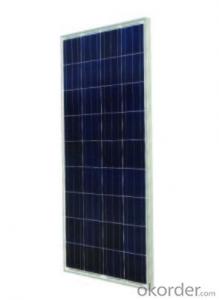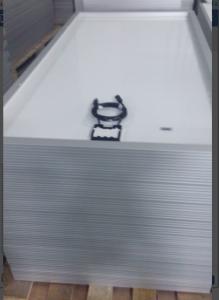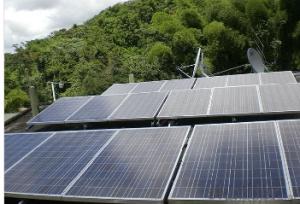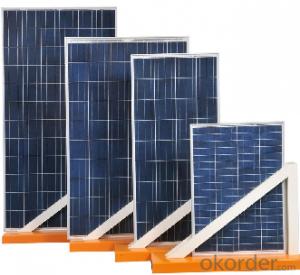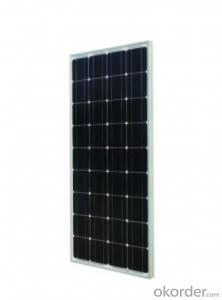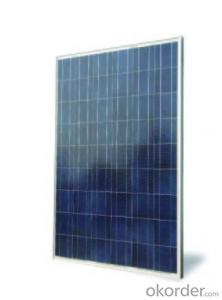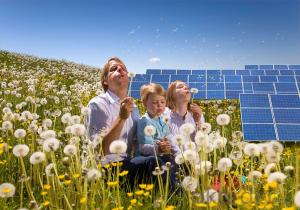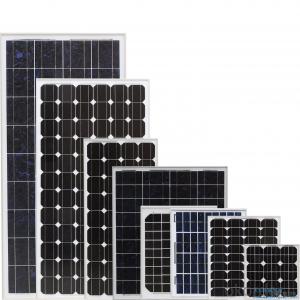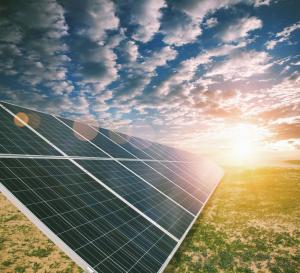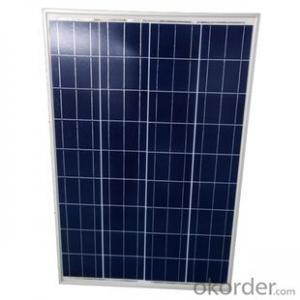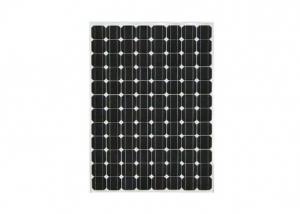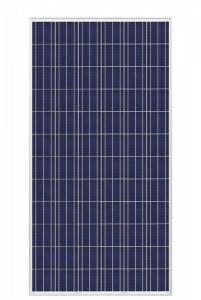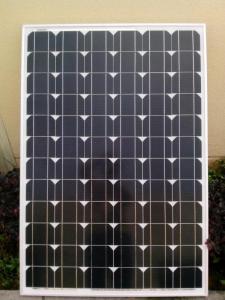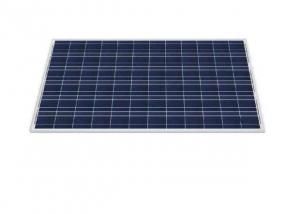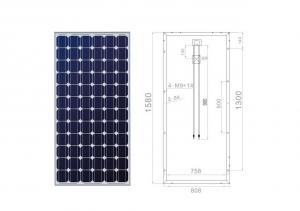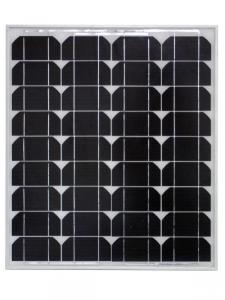Solar Panels BP Poly Crystalline Solar Panel RS145(P)-36
- Loading Port:
- China main port
- Payment Terms:
- TT OR LC
- Min Order Qty:
- 2000 watt
- Supply Capability:
- 1000000 watt/month
OKorder Service Pledge
OKorder Financial Service
You Might Also Like
Quality Assurance
10 Years Material & Craft
Power Guarantee
12 Years 90% Output
25 Years 80% Output
ISO9001:BSI
ISO14001:BSI
OHSAS18001:BSI
High Module Efficiency
Mechanical Load Capability up to 8000 Pa
Salt Mist Corrosion Protect Ammonia Resistance
Potential Induced Degradation Free
RS145P-36
RS135P-36
RS140P-36
RS150P-36
RS155P-36
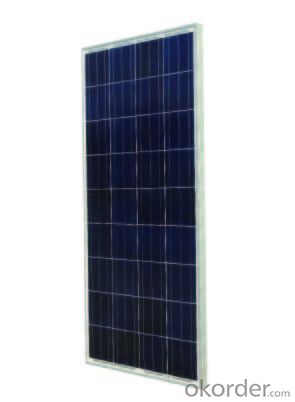
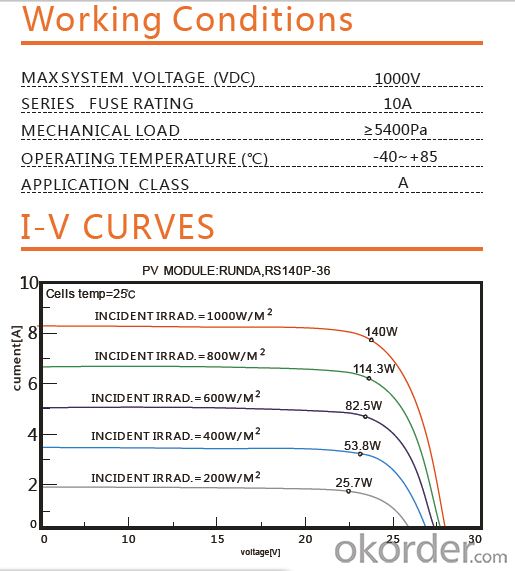
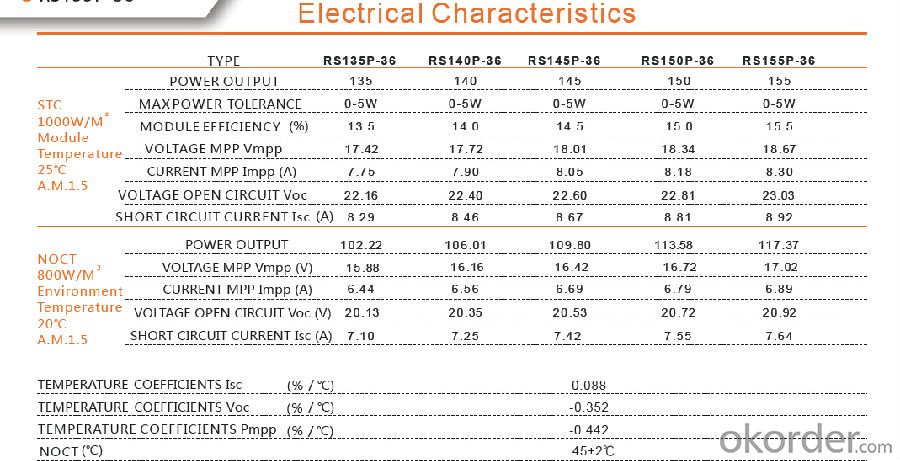
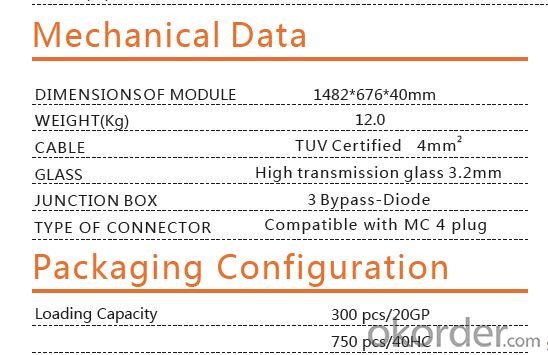
Structure of Solar Panels Description
Solar panel refers either to a photovoltaics (PV) panel, a solar hot water panel, or to a set of solar photovoltaics panels electrically connected and mounted on a supporting structure. A PV panel is a packaged, connected assembly of solar cells. Solar panels can be used as a component of a larger photovoltaic system to generate and supply electricity in commercial and residential applications. Each panel is rated by its DC output power under standard test conditions, and typically ranges from 100 to 320 watts. The efficiency of a panel determines the area of a panel given the same rated output – an 8% efficient 230 watt panel will have twice the area of a 16% efficient 230 watt panel. There are a few solar panels available that are exceeding 19% efficiency. A single solar panel can produce only a limited amount of power; most installations contain multiple panels. A photovoltaic system typically includes a panel or an array of solar panels, an inverter, and sometimes a battery and/or solar tracker and interconnection wiring.
Efficiencies
Depending on construction, photovoltaic modules can produce electricity from a range of frequencies of light, but usually cannot cover the entire solar range (specifically, ultraviolet, infrared and low or diffused light). Hence, much of the incident sunlight energy is wasted by solar modules, and they can give far higher efficiencies if illuminated with monochromatic light. Therefore, another design concept is to split the light into different wavelength ranges and direct the beams onto different cells tuned to those ranges. This has been projected to be capable of raising efficiency by 50%. Scientists from Spectrolab, a subsidiary of Boeing, have reported development of multijunction solar cells with an efficiency of more than 40%, a new world record for solar photovoltaic cells. The Spectrolab scientists also predict that concentrator solar cells could achieve efficiencies of more than 45% or even 50% in the future, with theoretical efficiencies being about 58% in cells with more than three junctions.
FAQ of Solar Panels
Q1:Can we visit your factory?
A1:Sure,welcome at any time,seeing is believing.
Q2:Which payment terms can you accept?
A2:T/T,L/C,Moneygram,Paypal are available for us.
Q3:How to guarantee the Quality of the products?
A3:We have established the international advanced Quality management system,every link from raw material to final product we have strict Quality test;We resolutely put an end to unQualified products flowing into the market. At the same time, we will provide necessary follow-up service assurance.
- Q: So my buddy and I have an idea to start a small Solar Installation business. Small as in I am only willing to do one weekend a month and two weeks a year(I know it sounds like the reserves). These are my specific question:) What is the average cost in the U.S. to have Solar Panels installed?2) What is the average cost in the state of Hawaii to install Solar Panels?3)Is this a worth while venture? (There's a good chance i'm going to ignore this one anyways LOL!)4)How long does it take to install a photovoltaic solar panel?5)How long does it take to install a hot water solar panel?6)Besides the obvious, what permits are needed to get our start?7)What education or Cert. is needed?8)Average time to start up?If there is any other information you believe pertinent to this subject that I didn't ask directly, please share. Thank you for your help in advance!
- Cba to read all that, but all I know is for 3 sola pannles it cost abot 5000 xxx
- Q: Can solar panels be used in areas with frequent thunderstorms?
- Yes, solar panels can be used in areas with frequent thunderstorms. While thunderstorms may temporarily reduce the efficiency of solar panels due to cloud cover and reduced sunlight, they do not pose any significant risk to the panels themselves. Properly installed solar panels are designed to withstand various weather conditions, including thunderstorms. Additionally, the energy produced by solar panels during sunny periods can still offset the electricity consumed during stormy periods, making them a viable option for areas prone to thunderstorms.
- Q: What is the principle of solar panels to convert solar energy into electricity?
- When the light is irradiated on the surface of the solar cell, a part of the photon is absorbed by the silicon material; the energy of the photon is transferred to the silicon atom, so that the electrons are moved and the free electrons are formed on both sides of the P-N junction to form a potential difference. When the circuit is used, the current will flow through the external circuit to produce a certain output power. The essence of this process is the process of converting the energy of the photon into electrical energy.
- Q: I am fairly new to the solar panel scene, and am eager to try to set one up myself instead of buying a kit. I am looking for a solar panel that puts out 00 Watts or more, and can produce more than 20 volts. Thanks
- a cheap one that doesn't burn up
- Q: Can solar panels be used to power a film set?
- Yes, solar panels can be used to power a film set. By harnessing the sun's energy and converting it into electricity, solar panels can provide a sustainable and renewable source of power for various film production needs, such as lighting, cameras, and equipment. This not only reduces the carbon footprint of the film production but also saves costs on traditional energy sources.
- Q: Is it possible for a 2V rated panel to charge a bank of batteries equal to around 36V? I believe that the panels should equal or exceed the voltage of the batteries but, I'm not for certain.
- With a 2 volt power source (solar panel, battery charger, vehicle charging system, etc...) you can charge three 2 volt batteries in parallel circuits then switch to a series circuit through a series/parallel switch to get 36 volts output. I've done this with my electric scooter so I can charge it with my pickup through the lighter socket when I'm away from home. It works great! When at home I just leave the switch in the 36 volt position, plug the charger in the wall receptacle and the charger puts out 36 volts. Actually 2 volt lead acid batteries have 2.6 volts when fully charged so the charging source has an output of 3.6 to 4.2 volts to effect a complete charge. In the series circuit the fully charged batteries would put out 37.8 volts so the charger would have an output of 40.8 to 42.6 volts.
- Q: I am looking to wire in some solar panels into my home. I already have plenty of wiring, and some solar panels around. I just need to know what I need to do to wire them into my home so I can lower my electric bill. This past month it was six hundred dollars.Can someone direct me to some information, or tell me how without telling me to hire some guy to come out to charge me thirty thousand dollars to install two or three thousand dollars worth of equipment?
- I okorder Hope this helps.
- Q: All I ever heard is how easy it is to get solar panels for a persons home. I live in Arkansas and to do my house it would cost 25000 that I dont have and No state incentives. So where do I go and get these free solar panels? Thanks for the help
- Sorry this is so long. I live in north west arkansas. I have solar on my home. I installed them myself. Did not cost me anywhere near 25 grand. Solar will pay you back if you get incentives or not. I have said this a hundred times but people just don't seem to understand or can't do the math. You are renting from the public utility. You have nothing in the end but a stack of payment stubs. There is no way to get a return on your investment. You paid them money and have nothing. Nothing at all .. Well maybe good service. But still nothing. If you check it out most solar electric systems last 30 years or longer. If your electric bill is 00 dollars a month. do the math. 00 dollars a month for 30 years is $36,000 dollars you would normally pay the public utility. So why not buy your $25,000 system, you just made $0,000 right there on the spot. Now add in 3.5% cost of living per year for each year for the next 30 years on that 35,000 you pay the public utility. Then you have to keep in mind you do not pay taxes on any electric you make yourself. You do not pay fees on your own power. You do not pay the cost of fuel incresses every time the price of oil goes up. In the end you saved $00,000. So it is free even if Arkansas don't give free handouts like other states. I even know people who say they are waiting for some one to make a cheaper solar module. That will not happen because even if they make it for half the cost (like evergreen is doing) it will still be sold at standard market value not production cost. The real problem with solar is it is hard to come up with the upfront cost. But renting solar panels is comming but that is the same as just renting power from the public utility. I wish you luck but it will be a while before Arkansas will make any moves on renewables. They just in 2007 made it law that the public utilities have to let your roll your net metering over to the next month if you over produced.
- Q: hi guys, i need help, okay lets say i decide to put solar panels near a place where its inhabitated by people, what kinda of environmental factors should i consider? Will the solar panels cause any damage to the enviromnent around it? Will it affect the plant and animals around it? should i consider the weather? its for my class so if u guys can help thankx.
- I wouldn't worry about what the solar panel is going to do to the surrounding environment, I would worry about what the surounding environment is going to do to the solar panels.
- Q: I wanna start going green, you know like solar panels, wind turbines, etc. but where I live the companies that install the free solar panels in exchange for the subsidiaries aren't available. To start off I was just looking for a single panel I could drill into my roof and wire it to an outlet just for small thinks like charging my phone and a fan maybe. If anybody can understand my crazy idea please answer with links to where I can find these things. Thanks!
- Sounds like an electrocution in the works. Try learning about grid tied and grid free solar system first.
Send your message to us
Solar Panels BP Poly Crystalline Solar Panel RS145(P)-36
- Loading Port:
- China main port
- Payment Terms:
- TT OR LC
- Min Order Qty:
- 2000 watt
- Supply Capability:
- 1000000 watt/month
OKorder Service Pledge
OKorder Financial Service
Similar products
Hot products
Hot Searches
Related keywords
